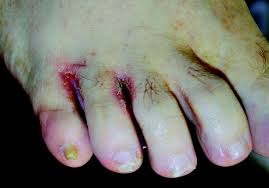
Erythrasma is a bacterial skin infection caused by the bacterium Corynebacterium minutissimum. It is typically characterized by red, brown, or pinkish patches of skin that may be itchy or scaly. Here are some key facts about erythrasma:
Causes:
- Erythrasma is caused by the bacterium Corynebacterium minutissimum.
- The bacteria thrive in warm, moist environments, and the infection is most commonly found in the folds of the skin, such as the groin, armpits, and between the toes.
Symptoms:
- Symptoms of erythrasma include red, brown, or pinkish patches of skin that may be itchy or scaly.
- The patches may have a well-defined border and may be slightly raised or bumpy.
- The infection may also cause a mild, musty odour.
Diagnosis:
- A diagnosis of erythrasma is usually made based on the appearance of the skin lesions and the patient’s medical history.
- A Wood’s lamp, which emits ultraviolet light, can be used to confirm the diagnosis by causing the affected skin to fluoresce.
Treatment:
- Treatment for erythrasma typically involves topical or oral antibiotics to kill the bacteria causing the infection.
- Anti-fungal medications may also be used if a fungal infection is suspected.
- Good hygiene practices, such as keeping the affected area clean and dry, can also help prevent the spread of the infection.
Prognosis:
- Erythrasma is usually a mild and easily treatable condition.
- With prompt and appropriate treatment, symptoms typically improve within a few days to a week.
- However, in rare cases, complications such as secondary bacterial infections or cellulitis can occur.
